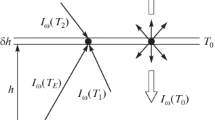Abstract
A kinetic equation for low-energy electrons induced in gas by ionizing radiation is studied. The kinetic equation takes into account elastic, inelastic, and ionization collisions between electrons and gas molecules, as well as the interaction with an external electric field. The process of the conduction current generation is considered. A small parameter is calculated as a ratio of the energy accumulated by an electron between collisions to the thermal energy. An approximate solution is constructed of the kinetic equation for electron concentration and flow. The study resulted in obtaining quadrature formulas for the calculation of electron conduction of an ionized gas in the model of a radiation-induced electromagnetic field.
Similar content being viewed by others
References
V. K. Fedorov, N. P. Sergeev, and A. A. Kondrashin, Control and Tests in the Design and Production of Electronic Equipment (Tekhnosfera, Moscow, 2005) [in Russian].
A. I. Chumakov, Impact of Spece Radiation on Integrated Circuits (Radio i Svyaz’, Moscow, 2004) [in Russian].
M. E. Zhukovskii and M. B. Markov, Mathematical Modeling of Radiation-Induced Electromagnetic Fields, in Encyclopedia of Low-Temperature Plasma, Series B, Vol. VII-I, Part 2 (FIZMATLIT, Moscow, 2005) [in Russian].
M. B. Markov and M. E. Zhukovskii, “Modeling the Radiative Electromagnetic Field,” International Journal of Computing Science and Mathematics 2(1/2), 110–131 (2008).
A. N. Andrianov, A. V. Berezin, A. S. Vorontsov, et al., “Modeling of Electromagnetic Fields on Multiprocessor Computing Systems,” Mat. Model. 20(3) (2008).
M. B. Markov, S. V. Parot’kin, and A. V. Sysenko, “Particle Method for a Model of an Electromagnetic Field of an Electron Flux in a Gas,” Mat. Model. 20(5) (2008).
National Institute of Standards and Teshnology. http//www.phys.nist.gov/.
C. L. Longmire, Elementary Plasma Physics, (Interscience Publishers, New York, 1963, Atomizdat, Moscow, 1966).
L. G. H. Huxley and R. W. Crompton, The Diffusion and Drift of Electrons in Gases (Wiley, New York, 1974, Mir, Moscow, 1977).
Y. Itikawa, “Cross Sections for Collisions of Electrons and Photons with Nitrogen Molecules,” J. Phys. Chem. Ref. Data 15(3), 985 (1986).
Y. Itikawa, “Cross Sections for Collisions of Electrons and Photons with Oxygen Molecules,” J. Phys. Chem. Ref. Data 18(1), 23 (1989).
S. Trajmar, “Electron Scattering by Molecules II. Experimental Methods and Data,” Phys. Rep. 97, 219 (1983).
G. J. Schulz, “Vibrational Excitation of N2CO, and H2 by Electron Impact,” Phys. Rev. A: 135(4), 988 (1964).
G. J. Schulz, “Vibrational Excitation of CO2 by Electron Impact,” Phys. Rev. Lett. 21, 1031 (1968).
G. J. Schulz, “Resonances in Electron Impact on Atoms,” Rev. Mod. Phys. 45(3), 378 (1973).
D. J. Spence, “Measurement of Total Inelastic Cross Sections for Electron Impact in N2 and CO2,” Chem. Phys. 57, 5516 (1972).
L. M. Biberman, V. S. Vorob’ev, and I. T. Yakubov, Kinetics of Non-Equilibrium Low-temperature Plasma (Nauka, Moscow, 1982) [in Russian].
D. C. Cartwright, “Electron Impact Excitation of the Electronic States of N2. II. Integral Cross Sections at Incident Energies from 10 to 50 eV,” Phys. Rev. A: 16, 1041 (1977).
A. Chutjian, “Electron Impact Excitation of He Electronic States of N2. III. Transitions in the 12.5–14.2-eV Energy-Loss Region at Incident Energies of 40 and 60 eV,” Phys. Rev. A: 16, 1052 (1977).
I. V. Kochetov, et al., “Velocities of Processes Induced by an Electron Impact in Nonequilibrium Plasma. Molecular Nitrogen and Carbon Dioxide,” in Plasmochemical Processes (Nauka, Moscow, 1979) [in Russian].
D. Rapp, “Cross Sections for Dissociative Ionization of Molecules by Electron Impact,” The Journal of Chemical Physics 42(12), 4081.
Yong-Ki. Kim, “Binary-Encounter-Dipole Model for Electron-Impact Ionization,” Phys. Rev. A: 50(5), 3954 (1994).
Yong-Ki. Kim, “Extension of the Binary-Encounter-Dipole Model To Relativistic Incident Electrons,” Phys. Rev. A: 62(5), 052710 (2000).
V. L. Ginzburg and A. V. Gurevich, “Nonlinear Phenomena in Plasma Located in an Alternating Electromagnetic Fiels,” UFN, Vol. LXX (1960).
R. Kubo, Statistical Mechanics: an Advanced Course with Problems and Solutions (Mir, Moscow, 1967; North-Holland, Amsterdam, 1965).
H. S. W. Massey and E. H. S. Burhop, Electronic and Ionic Impact Phenomena (Oxford University Press, New York, 1969, Izd. Inostr. Lit., Moscow, 1958) [in Russian].
N. L. Aleksandrov and E. E. Son, “Energy Distribution and Kinetic Coefficients of Electrons in Gases in an Electric Field,” in Plasma Chemistry No. 5 (Atomizdat, Moscow, 1978) [in Russian].
Author information
Authors and Affiliations
Corresponding author
Additional information
Original Russian Text © M.B. Markov, S.V. Parot’kin, 2011, published in Matematicheskoe Modelirovanie, 2011, Vol. 23, No. 4, pp. 41–56.
Rights and permissions
About this article
Cite this article
Markov, M.B., Parot’kin, S.V. Kinetic model of radiation-induced gas conductivity. Math Models Comput Simul 3, 712–722 (2011). https://doi.org/10.1134/S207004821106007X
Received:
Published:
Issue Date:
DOI: https://doi.org/10.1134/S207004821106007X




